Course 2: Search Engine Optimization Fundamentals
- Week 1 – Getting Started and Introduction to On-page SEO
- Key elements of effective SEO Strategy
- How to select keywords and perform keyword research
- Relevancy, intent, and competitiveness
- Analyze keyword competitiveness
- Consumer psychology and search behavior
- On-page SEO analysis to identify opportunities to improve a website’s search optimization
- Key areas of SEO:
- On-site optimization – Optimizing elements of a page or groups of pages to optimize for SEO
- It’s called on-page optimization because it’s elements or code of a page which involves:
- Content
- Keyword Choice
- Meta Data
- It’s called on-page optimization because it’s elements or code of a page which involves:
- Technical Optimization – How well a site is seen and understood by search engines.
- Improve the code of the site and structure of it
- You can make great on page changes but if search engines can’t find it it’s useless
- Off-site optimization – Actions you can take outside of your website to optimize your website
- Similar to public relationships
- Creating relationships with other webmasters
- Acquiring inbound links
- Engaging in social media
- Writing link worthy content
- On-site optimization – Optimizing elements of a page or groups of pages to optimize for SEO
- How to select keywords and perform keyword research
- Resources:
- On-site Optimization
- Core concepts
- Meta Data and Meta Tag
- Recognize individual Meta-Data elements from a search result
- Anatomy of a search results
- Meta Data – When you search for something and you get summary information of the site (Data that describes other data)
- Title (Title Tag)
- Site URL (Website address)
- Site description (Meta Description)
- Meta Tags – are used when you code a website to help identify important information about the page (Found in source code)
- Meta Data – When you search for something and you get summary information of the site (Data that describes other data)
- Title Tags
- View source to see code
- <Title></Title> tag
- Use Moz bar to find page elements
- One of the most important on-page elements to optimize
- Recommendation order of Title tag <title> Description of page | Brand</title>
- Google places more emphasis on the beginning of the title tag rather than the end. Put keywords closer to the beginning of title tag.
- Title tags no longer than 55-60 characters in length. 55 or less is better.
- Use only most important keys (Use two keywords in title tag)
- Avoid special characters
- Shorten brand name if it’s too long
- Meta Descriptions
- Meta descriptions don’t help pages rank BUT it can help direct website traffic

- Metadata is highlighted in yellow
- Describes what the page is about
- To see the metadata you need to –> Look at source code –> right click –> view page source –> “meta name = description”
- You can also use the Moz bar add-on.
- Search engines will not look for keywords in meta description BUT it helps get people to click on your site.
- Keywords are bolded in the search engine helping people click the site
- About 1-2 sentences (160 characters in length) show on the description.
- Description of content, having keywords, and CALL TO ACTION (CTA) telling a client what to do they are more likely to listen and follow the direction.
- Another good reason to have good meta description about your page is social media posts. When someone shares your article, the description will be shown on the shared thread.

- It needs to be catchy to get people to click
- Best practices:
- 160 characters or less
- Include keywords
- Include CTA
- Meta Keywords Tag
- Not a focus of SEO anymore
- Search engines weren’t capable of understanding a site so Meta Keywords Tag was necessary
- Not seen by users
- Some search engines use it but it’s very rarely the case (Baidu still uses it – Must be in chinese)
- Death of Meta keywords
- URL Optimization
- Optimize through Keywords, subdirectories, parameters
- URL definition – Address that loads a particular site
- URL should have keywords in it towards the beginning
- Not as important but still useful.
- Keywords help for Off-page SEO when people are linking to your site. It helps viewers determine how relevant it is.
- Keywords should be used in subfolders/subdirectories

- Keywords in URL will show up in bold
- Parameters in green below

- Being part of the website creation and URL naming as an SEO expert is best but often not the case. You can change it later on but it erases the credibility the name of the site already created. It’s like getting a new credit score. You lose your past history.
- URL Best Practices
- don’t change URLs lightly
- Use 301 redirects if you do
- Optimize URL from the start
- Use keywords in URL
- Use keywords in subdirectories
- Keep URLs short
- Heading Tags
- Primary heading H1 – Most important
- Secondary heading H2 – Important
- H3 and on aren’t really used for search engines for ranking
- Optimize headings with keywords if they are naturally incorporated.
- View source code or Moz add-on to view heading tags.
- Sometimes heading tags are used when they shouldn’t be used. This should be optimized.
- Use keywords in heading tags as much as possible if you can make it seem natural.
- Content and Optimizing Unique Content
- Make keywords fit naturally
- Make content relevant to the theme of your site
- Well organized in subdirectories
- Create your own unique content
- Copied content does not help rank
- If you use other peoples content it could hurt you
- Link back to the page you are quoting
- Google gives credit to the first person who created the content
- Don’t duplicate your content. Each page should be unique
- Copying and changing words does not make it unique
- Duplicated pages will cannibalize the other
- Add video or images
- Adding video, images, links, and downloads makes your content better because it’s usually more useful to a viewer.
- If it’s just a block of text, Google doesn’t think it’s as helpful.
- When you link to another site make sure they aren’t spammy sites
- Use keywords but not too many of them. If you do, Google can view it as SPAM.
- It should sound natural
- Use synonyms. Google can view synonyms and reinforce the theme of your keywords and article.
- Linking
- Link to other relevant pages on the site
- Helps search engines to crawl your site
- Link with anchor texts (Don’t link with “click here” but rather link the keywords to the other page about the keyword)
- Best practices:
- Relevant, well-organized, and unique
- Do no “over-optimize”
- Use synonyms for your keywords to help search engines understand your page
- Use writing at the level of your intended audience. It helps with user-friendliness
- Add resources: Images, documents, Video, and relevant links
- Analyzing a Website Using a Web Crawler
- You can analyze a website all at once using a web crawler
- Export data to Excel
- Resource:
- Crawler or Spider – Screaming Frog
- Core concepts
- Key elements of effective SEO Strategy
- Week 2 – Introduction to Off-site/page SEO
- We’ll learn:
- Link analysis
- Create and edit backlink
- Use social media to build brand authority
- Off-site SEO are the efforts that you can take to optimize your website off your site.
- Building links to your site
- Build brand awareness on social media
- Differentiate from high PageRank to earning site authority
- PageRank -Algorithm
- Created by Larry Page
- It was an algorithm that analyzed web links to determine the relative importance of websites
- The term isn’t used as much
- When another website links to your website, it’s counted as a vote
- The more links the higher the page rank (0-10)
- All websites started at 0
- Twitter was a 10
- 2013 was last time PageRank was updated. No longer used
- Ranking factors are unknown but links are important. Too many people manipulated the linking technique.
- Linking to high-quality websites matters more now.
- How Google Analyzes links
- Amount of links your website has
- Quality of the links
- The relevance of the links to your site (Are they connected in a theme?)
- Placement of the links
- Footer and sidebar are less valuable, possibly spammy.
- Partner or Sponsor text is not good.
- The best type of link is surrounded by text, so within the body of the text.
- Click here anchor texts aren’t good. They should be key words that are the text that is used as a link.
- Google also looks if you’re doing reciprocal links. If you are, they both become invalid.
- Link disavow tool – Webmasters can disavow bad links with the Google Disavow Tool
- Try removing links yourself before using these tools
- Acquire new backlinks from authoritative sites
- Create strong backlinks – Moz
- Social media strategy to enhance SEO
- Twitter and Pinterest for SEO
- Google has stated they do not factor in social media for ranking but Google looks at links. Links and tweets don’t directly impact your SEO but it can increase visibility in search results
- By getting more brand awareness, this does help increase your ranking.
- Pinterest boards are indexed on search engines
- Rank well for long tail keywords
- Boards with active followers rank better
- Social media has secondary benefits
- Resources:
- We’ll learn:
- Week 3 – Introduction to On-site Optimization (Technical SEO)
- What we’ll learn:
- Building a strong structural foundation for your site for search engine robots to search and index
- HTML and XML sitemaps and robots.txt
- Learn about common error codes – temporary or permanent redirects can help user experience and preserve authority of your site
- Technical SEO focuses on how well search engines can crawl your site and index your content
- Order of operations for an optimized SEO strategy:
- Technical SEO
- On-page/site SEO – Content/Keywords
- Off-page SEO signals
- Technical SEO concerns:
- XML sitemaps
- Robots.txt files
- Site errors
- 404 page best practices
- Appropriate redirects
- HTML sitemaps vs. XML sitemaps – Need both for your website design
- Sitemaps point search engines to pages on your site. They help make sure pages are not missed by crawlers
- HTML sitemaps are easy to read and understand by users
- XML sitemaps are made for search engines
- Includes unique information about each URL
- When the page was last updated
- How often pages change
- Page importance in relation to other pages on your site
- XML sitemaps are especially helpful for new sites
- Websites are found by crawlers using site links so it takes some time before new sites are found.
- You can upload your sitemap to Google or Bing which helps inform search engines about your new website and pages
- You can create an XML sitemap for your website with Screaming Frog tool
- Includes unique information about each URL
- Robots.txt – Protocol to specify which pages to NOT index
- Simple text file uploaded to the server
- Crawlers will first go to your websites robots.txt file to see if there are any instructions on what pages not to crawl.
- Robots can choose to ignore info in this file. Search engines and known brands tend to respect this file
- Some bots are used to scan for vulnerabilities in order to hack a site
- Others harvest emails
- Your robots file is a public file so anyone can see what pages you don’t want crawlers to see.
- Robots.txt file
- robots.txt files are found on a websites main URL like coursera.org/robots.txt
- The top portion of the file basically is a description to describe the file. It’s not necessary but most CMS websites automatically include it.
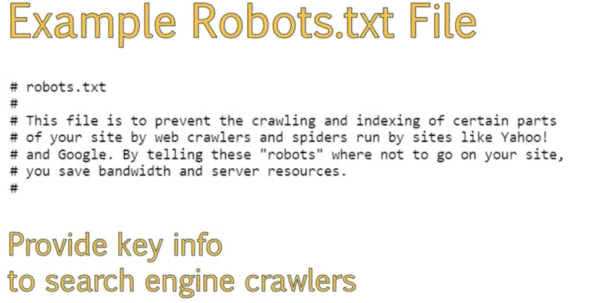
- Must be used at the root of your host:
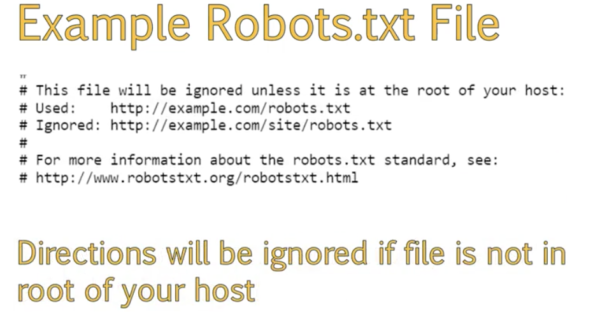
- Next section describes what user-agent aka what crawlers should follow the disallow crawling. You could specify Google or Bing not to crawl these pages but the asterisk is a catch-all for all robots should not crawl your site.
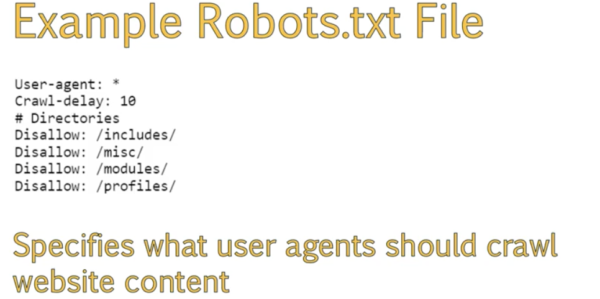
- Crawl-delay determines how many seconds before a crawler can access another page to your site so it doesn’t crash your site.
- Pound or hashtag is used for notes for humans to read. Crawlers overlook them.
- Overcoming Error Codes
- Frustrating for user and causes issues for SEO.
- HTTP response status codes – Helps developers determine what went wrong with a site that couldn’t load.
- 3 digit codes
- They either start with 4XX or 5XX
- Common status codes
- 200 – Page loaded properly
- 404 – Page cannot be found
- Not to include in the index
- Soft 404s are pages that no longer exist but show they are loading okay as 200.
- This happens when content is removed but the page is left in place
- This usually happens on e-commerce sites when a product is no longer being sold or on real estate sides where the listing is no longer available.
- Very bad for SEO
- SEO will consider the page existing but containing the same error message which looks like duplicate content or thin content/not helpful.
- You can use google search console to see which sites are possibly loading as soft 404 pages.
- 500 – Server error
- Temporary and usually gets corrected
- Developer might need to look at server logs to determine issue if they are not temporary
- 503 – Service unavailable
- You’ll see it when the server is down for maintenance
- Redirects 101
- Three types of redirects
- Permanent
- Temporary
- Meta refresh
- A redirect is a status code
- Common redirect codes applicable to SEO
- 301 HTTP status code – Permanent
- Search engines will give the same ranking to the new page as the old
- Usually, about 5% of page authority is lost
- 302 HTTP status code – Temporary
- Search engines will not give the same ranking to the new page as the old
- Generally, recommend 301 over a 302 site redirect
- Chain redirecting (A –> B –> C) should have A –> C and B –> so you can retain more of your site authority.
- Redirects for pages that no longer exist, don’t automatically redirect to the home page. Redirect to a specific page, if not then category level page, and finally home page if you need to. This helps search engines with navigating the website and a better user experience.
- 307 HTTP status code – Newer on for 302 but you’ll still see 302
- 301 HTTP status code – Permanent
- Meta refresh status code
- Executed at the page level instead of the server itself
- Slower
- “If you are not redirected within five seconds” — Meta refresh
- Poor user experience
- Doesn’t tell search engines what to do
- Three types of redirects
- Best practices for 404 pages
- Error page when page is not found
- Most common error pages
- Search engines know how to handle 404 sites so it doesn’t impact it as much but you should still remove as much 404 pages as possible.
- Soft 404 pages are more problematic. They should be fixed.
- Sometimes 404 pages are just what you need.
- 404 pages that have significant authority should be redirected to preserve authority. Send to a relevant page or category, and lastly home page.
- On the 404 page, a best practice is giving them helpful links to other relevant pages on your site.
- Helps with crawlers too because it helps the crawler crawl the rest of your site
- Display Error message with a description so they know what happened
- Include a call to action to know what to do next
- Homepage link
- Search box to search for other things on the website.
- Tools:
- Resources:
- Technical SEO by Hubspot
- The Art of SEO: Mastering Search Engine Optimization
- What we’ll learn:
- Week 4 – Keyword Theory & Research
- Overview:
- Determine optimal keywords for your site
- Learn important habits and preferences of internet searchers
- Use audience data to create personas of our ideal buyer
- Choosing Right Keywords
- Refine keywords for your audience
- One main function of SEO is to research how people search
- Keep search intent online when choosing keywords
- Be more specific when choosing keywords for your website.
- i.e if you’re a PC gaming site don’t just use the word “game” since it’s too broad of a category. Use PC online gaming
- Attract relevant traffic by being specific in keyword chooses, thinking about what the customer might be thinking about.
- Stages of Search
- There are three main types of searches that people perform: Navigational, Informational, and Transactional.
- Most people will start with a broad topic of search then refine as they find more information that is relevant to them.
- Purchase path:
- Awareness
- Generally knows what they are looking for but haven’t refined yet.
- I.e. Bob wants to buy a computer but hasn’t decided what type (laptop, pc, gaming pc, etc)
- Gains awareness of your brand, product, or service
- Evaluation
- After awareness, Bob starts refining the type of computer he wants.
- Then he does research on different brands and pricing.
- Compare merchants and prices
- Preference
- Here Bob has determined the preference of computer he’s looking for.
- Evaluate and develop a specific preference
- Purchase
- Bob knows exactly what he wants, know he just needs to find from whom he will be purchasing it from.
- Awareness
- Type of Search Queries
- Navigational
- User has a specific website in mind.
- They go directly to your website through search.
- You have to be aware of news that has your brand name in it.
- Social media is also pulled up so make sure the social media team focuses on brand focus
- Informational
- Gain more information to make an informed decision before a purchase
- i.e. Laptop reviews
- Look at search suggestions to help with potential content ideas
- Transactional
- Ready to buy
- Want to buy a specific item
- Navigational
- Heads, Tails, and Long Tail Keywords
- Long tail keywords – keywords have lower search volume
- Generally, have lower search volume but are typically better search keywords because you’re getting very targeted people.
- Low competition and generate better traffic
- Head terms – Highest search volume words
- Highly competitive
- More broad
- Mid Tail – More specific and has a medium volume of searches
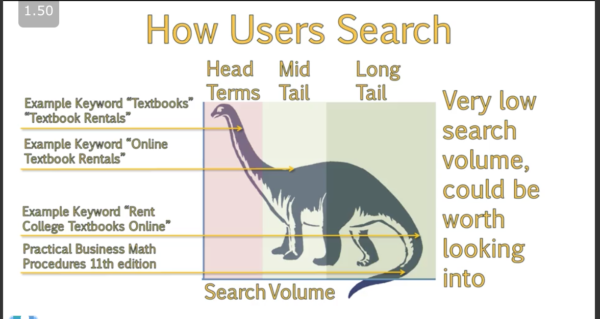
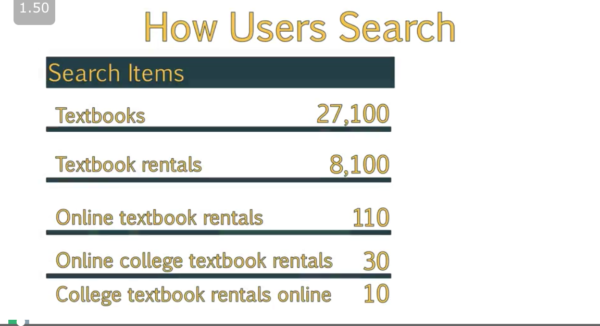
- Using head keywords can be very competitive because you have big brands that are focusing on them.
- If you use long tail keyword phrases, you can use different formats of the long tail keyword phrases like online college textbook, college textbook rentals, online textbook rentals online.
- By creating content around those keyword phrases you can create more authority for the main keyword textbook and be ranked higher.
- Long tail keywords – keywords have lower search volume
- The Science of How Users Conduct Searches
- Statistics of search preferences
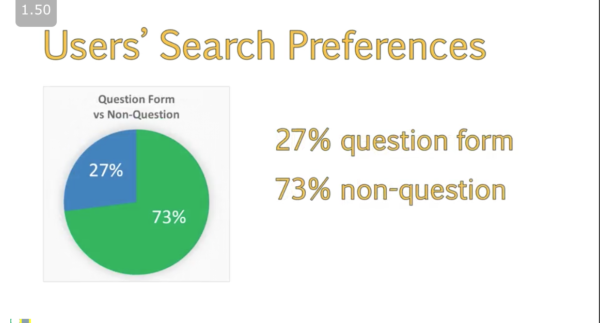
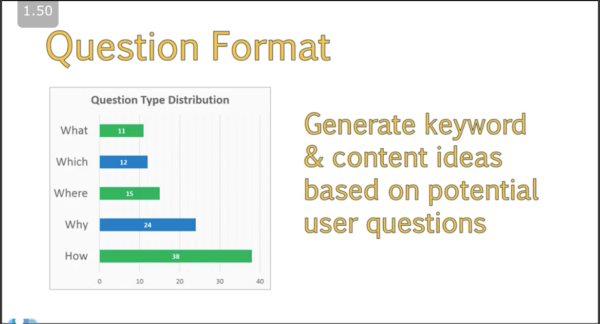
- What textbooks are available online?
- Where is the best place to rent textbooks?
- How do I rent textbooks online
- Why should I rent textbooks instead of buy?
- Knowing these questions can provide great content ideas.
- Seasonality Trends
- Site traffic changes at different times of the year
- Understanding seasonality trends can help with when to do website remodels. If it’s a peak season it might not be a good idea to do a remodel of the site during peak season. If you do it during the slower season, you have more time to optimize and build content authority.
- Getting to Know Your Audience
- Recommend tools for audience
- Google Trends – See what the world is searching
- Alexa – Demographic data
- You can see top keyword search from different sites.
- Similar Web
- Followerwonk – Helps analyze Twitter info
- Google Analytics
- Quantcast
- Recommend tools for audience
- Creating Your Ideal Buyers Persona
- Create fictional characters representing specific users of a website
- Create a website that speaks to the persona that you built
- Okay to have multiple personas to appeal to
- Characteristics of buyer persona
- Persona’s Age
- The age of your buyer will determine the types of keywords they use when searching on the web
- Persona’s Location
- Regional vocabulary differences. Slang, products, etc.
- Pop vs soda
- British vs American vocabulary
- Regional vocabulary differences. Slang, products, etc.
- Persona’s Gender
- Persona’s Age
- Building buyer persona
- Have an image of your persona
- Give him a name
- Profession
- Finances
- Problems
- Other Traits
- Statistics of search preferences